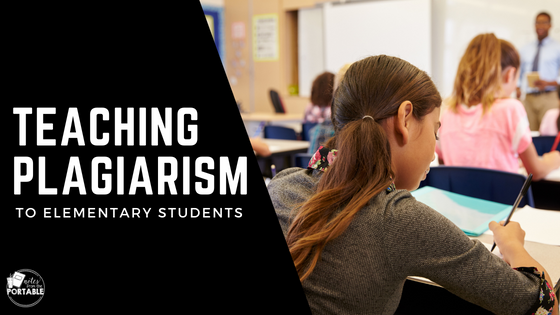
Plagiarism is a hard concept. So how can you prepare for teaching plagiarism to elementary students as they make the leap from learning to read to using the information they read?
As young readers they have been taught to find the evidence in the passage, to tell where they found the information or to copy from the text to demonstrate reading comprehension. As they make the leap to using the information they read to write reports, they often use the reading strategy of copying the “answer” from the text.
You can easily spot this in student writing. There are words in their sentences they cannot read or words that you know are not part of their vocabulary. So how do you help them learn how to avoid plagiarism as they grow as readers and writers?
Teaching Plagiarism Example for Students
To drive home the true meaning of plagiarism, I have a lesson where certain students are rewarded for copying the work of others. This lesson is one of the best ways I have found to teach plagiarism to elementary students.
Here are the steps:
- Have the students come in and pick a partner. They then decide who will be #1 and who will be #2.
- The #1 people get a piece of paper and a pencil and the #2, come to the carpet, color, or do something while they wait.
- #1 people write a paragraph about a topic (I usually pick something they just finished in science or social studies).
- Give them 5 minutes to do this.
- Tell #2 to go back, get the paper and pencil.
- Then they are told to write their name at the top of the paper and bring it to me.
- I tell them what amazing paragraphs they wrote and give them a piece of candy.
This usually sparks arguing from #1 people and #2 people asking if they can get candy for their partners.
Wrapping Up this Lesson:
Once everyone gets the prize, I show my learning target about plagiarism. I then give a super short intro about how authors feel when you copy their work word for word and turn it in for a grade. Then I let the #1 people get a candy too. I let them enjoy their prize while I talk about how plagiarism can cause you to fail or get expelled from schools.
Ways to Avoid Plagiarism:
After this I talk about what info is needed when citing sources, I like to use this guide to help students learn the information needed when you cite a source. I guide students on where to find this information. We also talk about why the copyright date would be important when writing informational pieces.
After teaching this guide, I showed them that many places make it easy for them to cite sources. Our state has a virtual library (SC DISCUS) that we can use for free if we live in that state. Through this virtual library students have access to an online encyclopedia, magazine articles, videos and so much more. These sites have a place where students can copy the citation for the articles or videos they use in their projects. (Side note – you will probably have some kid who will ask, well if you copy the citation, isn’t that plagiarism.) We discuss that just citing the sources doesn’t give you permission to steal their work by copying it word for word.
Teaching plagiarism is an important topic for students. Teaching note-taking activities will also help them learn to not just copy from the page. This lesson drives home the importance of using your own words when doing research. It also helps students to learn to give credit to the work they use of others.
Guide students through the research process with this Research Journal, Posters, and Guides.

Leave a Reply